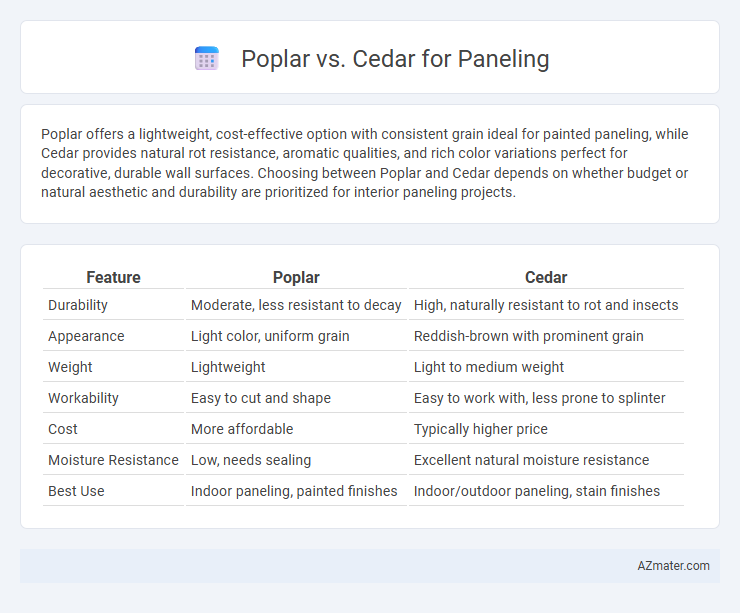Poplar offers a lightweight, cost-effective option with consistent grain ideal for painted paneling, while Cedar provides natural rot resistance, aromatic qualities, and rich color variations perfect for decorative, durable wall surfaces. Choosing between Poplar and Cedar depends on whether budget or natural aesthetic and durability are prioritized for interior paneling projects.
Table of Comparison
| Feature | Poplar | Cedar |
|---|---|---|
| Durability | Moderate, less resistant to decay | High, naturally resistant to rot and insects |
| Appearance | Light color, uniform grain | Reddish-brown with prominent grain |
| Weight | Lightweight | Light to medium weight |
| Workability | Easy to cut and shape | Easy to work with, less prone to splinter |
| Cost | More affordable | Typically higher price |
| Moisture Resistance | Low, needs sealing | Excellent natural moisture resistance |
| Best Use | Indoor paneling, painted finishes | Indoor/outdoor paneling, stain finishes |
Introduction to Poplar and Cedar for Paneling
Poplar and cedar are popular wood choices for paneling, each offering distinct characteristics. Poplar is a hardwood known for its smooth texture and pale, consistent coloration, making it ideal for painted finishes and modern interiors. Cedar, a softwood, provides natural resistance to moisture and insects, featuring warm tones and aromatic qualities that enhance rustic or natural-themed spaces.
Appearance and Grain Differences
Poplar paneling features a smooth, pale surface with subtle grain patterns, often displaying a light yellow-green to creamy white hue that complements modern interiors. Cedar paneling exhibits rich, reddish-brown tones with prominent, straight grain lines and occasional knots, offering a warm, rustic aesthetic prized in traditional or cabin-style designs. The distinct grain and color variations between poplar and cedar make each wood ideal for contrasting decor styles, with poplar suited for clean, minimalist looks and cedar enhancing natural, textured environments.
Durability and Hardness Comparison
Poplar paneling offers moderate durability with a Janka hardness rating of about 540, making it softer and more prone to dents and scratches compared to cedar. Cedar has a lower Janka hardness around 350 but provides superior natural resistance to decay, insects, and moisture, enhancing its longevity in paneling applications. For interior paneling where durability against wear is needed, poplar is preferred, while cedar excels in environments with higher exposure to humidity and pests.
Resistance to Decay and Insects
Poplar paneling offers moderate resistance to decay and insect damage but requires proper sealing and maintenance to enhance durability. Cedar excels in natural resistance to decay and insect infestations due to its aromatic oils and dense grain, making it ideal for long-lasting paneling in both interior and exterior applications. Choosing cedar for paneling ensures higher protection against environmental elements without frequent treatments compared to poplar.
Workability and Ease of Installation
Poplar offers superior workability due to its uniform texture and softness, making it easy to cut, sand, and paint for paneling projects. Cedar, while slightly harder, provides natural resistance to moisture and decay, which can simplify installation in damp or outdoor environments. Both woods are lightweight, but poplar's smooth surface reduces the likelihood of splintering, enhancing overall ease of installation.
Cost and Availability
Poplar paneling is generally more affordable than cedar due to its faster growth rate and widespread availability in North America, making it a cost-effective choice for budget-conscious projects. Cedar, while more expensive, offers natural resistance to decay and insect damage, often sourced from the Pacific Northwest or imported varieties, which can affect its price and lead time. Availability of poplar is consistent year-round in most regions, whereas cedar availability may fluctuate seasonally, influencing both cost and project scheduling.
Environmental Impact and Sustainability
Poplar paneling is known for its fast growth rate and renewable nature, making it an environmentally sustainable choice with lower carbon footprint due to efficient land use. Cedar, while slower to mature, offers natural resistance to decay and insects, reducing the need for chemical treatments and extending the panel's lifespan, which contributes to long-term sustainability. Both woods are biodegradable, but poplar's rapid regeneration aligns better with sustainable forestry practices, whereas cedar's durability minimizes replacement frequency.
Maintenance Requirements
Poplar paneling requires minimal maintenance due to its smooth grain and resistance to dents, but it benefits from periodic sealing to prevent moisture damage. Cedar paneling demands more upkeep, including regular sealing or staining to maintain its natural oils and protect against rot, insects, and weathering. Both woods can retain their appearance longer with consistent care, but cedar's aromatic properties and durability often justify the extra maintenance effort.
Best Uses and Applications
Poplar offers a smooth texture and light color that absorbs paint well, making it ideal for interior paneling, decorative moldings, and furniture where a painted finish is desired. Cedar's natural resistance to moisture, decay, and insects makes it perfect for exterior paneling, saunas, and areas with high humidity or exposure to the elements. Poplar suits indoor applications requiring easy staining or painting, while cedar excels in outdoor or moisture-prone environments demanding durability and natural aroma.
Final Verdict: Choosing Between Poplar and Cedar
Poplar offers a cost-effective, smooth surface ideal for painted paneling, while cedar provides natural resistance to moisture and insects, making it suitable for humid or outdoor environments. Poplar's lighter weight and ease of working appeal to interior projects, whereas cedar's rich aroma and distinctive grain enhance aesthetic appeal and durability. Choose cedar for longevity and natural protection, or poplar for budget-friendly, versatile indoor paneling.

Infographic: Poplar vs Cedar for Paneling
 azmater.com
azmater.com